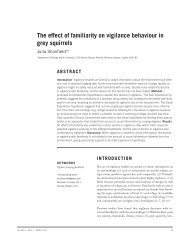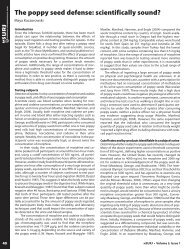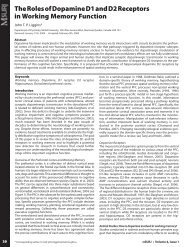the entire issue - McGill Science Undergraduate Research Journal ...
the entire issue - McGill Science Undergraduate Research Journal ...
the entire issue - McGill Science Undergraduate Research Journal ...
Create successful ePaper yourself
Turn your PDF publications into a flip-book with our unique Google optimized e-Paper software.
Operational transformation in cooperative software systems<br />
3.<br />
Intention preservation: For every operation O, <strong>the</strong> intention<br />
of O at <strong>the</strong> initial site where O is initially submitted will be identical<br />
to executing O at all o<strong>the</strong>r sites. The intention of an operation<br />
O is defined as <strong>the</strong> resulting document which is achieved by<br />
applying O on <strong>the</strong> document state from which O was generated.<br />
The convergence property guarantees that <strong>the</strong> document will be<br />
correct at <strong>the</strong> end of any particular editing time period, while <strong>the</strong><br />
causality preservation property guarantees that <strong>the</strong> document will<br />
be correct at any point during editing. The intention preservation<br />
property is similar to <strong>the</strong> convergence property, but additionally<br />
deals with <strong>the</strong> situation where operations are submitted from two<br />
different initial document states. This property is often <strong>the</strong> most difficult<br />
to achieve, and often requires a submitted operation by one<br />
client to be modified once received by ano<strong>the</strong>r.<br />
Operational transformation<br />
Operational transformation (OT) is a class of optimistic concurrency<br />
algorithms and data structures that are well-suited to satisfying <strong>the</strong><br />
three properties of <strong>the</strong> consistency model of collaborative editing<br />
systems discussed above. The OT mechanism can be divided into <strong>the</strong><br />
models that represent <strong>the</strong> data and its changes, and <strong>the</strong> algorithms<br />
that are used to ensure <strong>the</strong> correctness of <strong>the</strong> system (1, 3, 4, 5).<br />
Basic example<br />
The basic operational transformation technique (inclusion transformation)<br />
can best be illustrated by a simple example. Say we are given<br />
a text document, containing <strong>the</strong> sentence:<br />
“operational transformation is very fun”<br />
Now, two users, A and B, each simultaneously submit an operation on<br />
this document. For <strong>the</strong> purpose of demonstration, an operation has<br />
<strong>the</strong> signature Operation(position, string), where “position” represents<br />
<strong>the</strong> index of a word in <strong>the</strong> sentence, and “string” is <strong>the</strong> target string<br />
we want to operate on:<br />
1.<br />
2.<br />
User A submits <strong>the</strong> operation O A<br />
, Insert(0, ‘using’), inserting <strong>the</strong><br />
word “using” at <strong>the</strong> beginning of <strong>the</strong> sentence.<br />
User B submits <strong>the</strong> operation O B<br />
, Delete(4, ‘very’), deleting <strong>the</strong><br />
word “very” from <strong>the</strong> 4th word of <strong>the</strong> sentence.<br />
If we perform <strong>the</strong>se operations in <strong>the</strong> order above without transforming<br />
<strong>the</strong>m, we get <strong>the</strong> following result:<br />
“using operational transformation very fun”<br />
As <strong>the</strong> second operation deletes <strong>the</strong> 4th word, which accidentally<br />
deletes “is” instead of “very”. Instead, we need to transform <strong>the</strong> positional<br />
parameter of O B<br />
by one in order to obtain <strong>the</strong> correct result,<br />
which our OT transformation algorithm can calculate and perform,<br />
giving us Delete(5, ‘very’) instead. This gives us <strong>the</strong> correct result:<br />
Data models<br />
“using operational transformation is fun”<br />
Data models in OT are <strong>the</strong> representations of <strong>the</strong> data in a particular<br />
collaborative session. A data model can represent a document, a<br />
spreadsheet, a drawing, or any o<strong>the</strong>r object that different clients can<br />
collaboratively operate on. The most basic OT data model is that of a<br />
linear space in memory, such as that of a single string (1).<br />
Recent developments in OT have allowed <strong>the</strong> development of more<br />
complex OT data models, such as those involving rich-text editing<br />
with markup or an advanced application state represented in JSON<br />
(JavaScript Object Notation). However, as <strong>the</strong> data models used in OT<br />
become more complex, so do <strong>the</strong> models that are necessary to represent<br />
a particular operation on <strong>the</strong> data.<br />
Operation models<br />
An operation is <strong>the</strong> fundamental block of <strong>the</strong> OT mechanism, and in<br />
<strong>the</strong> simplest OT data model, an operation is simply an insertion or<br />
deletion of a single character in memory. As well, more advanced<br />
operations can be created from combining insertions and deletions,<br />
such as a substitution operation (a combination of an insertion and<br />
deletion operation) (10, 11).<br />
For advanced data models that may use more than a linear space in<br />
memory, we often find more complex operations such as moving data<br />
between memory addresses. For example, OT word processors can<br />
add operations to start and close annotation boundaries to represent<br />
markup tags, and OT JSON structures can have edit operations on<br />
particular lookup paths of a JSON object.<br />
Past research attempted to generalize OT data and operation models,<br />
and to only allow insertion, deletion, and substitution operations on<br />
<strong>the</strong> data. However, for most modern OT implementations, application-specific<br />
data and operation models are used. These also require<br />
operation transformation functions to maintain <strong>the</strong> intention preservation<br />
property, one for each pair of operations, as each type of operation<br />
must be able to be modified by <strong>the</strong> OT control algorithm relative<br />
to each o<strong>the</strong>r operation type. Thus, for N application-specific<br />
operations, N x N transformation functions are required for OT (13).<br />
Operation composition<br />
For each client in <strong>the</strong> collaborative system, each client must perform<br />
three different activities (12):<br />
64<br />
<strong>McGill</strong> <strong>Science</strong> <strong>Undergraduate</strong> <strong>Research</strong> <strong>Journal</strong> - msurj.mcgill.ca









